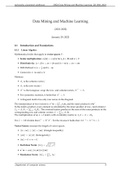Summary
Data Mining and Machine Learning (2IIG0): summary
- Course
- Institution
This document contains a summary with all the necessary functions for you to know for the exam. It includes the notes made by the teacher in the online lectures that are not on the slides. It only includes the first part of the Data Fusion lecture. And there is nothing about How to Lie with Data,...
[Show more]



